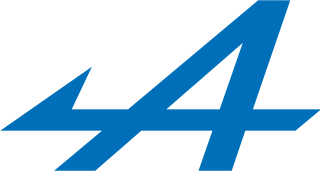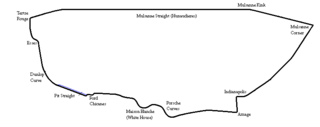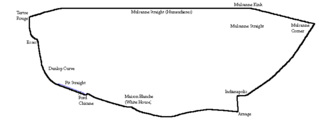
The Société des Automobiles Alpine SAS, commonly known as Alpine, is a French manufacturer of sports cars and racing cars established in 1955. The Alpine car marque was created in 1954.

The V6 PRV engine is an automobile petrol V6 engine that was developed jointly by Peugeot, Renault and Volvo Cars – and sold from 1974 to 1998. It was gradually replaced after 1994 by another joint PSA-Renault design, known as the ES engine at PSA and the L engine at Renault. It was designed and manufactured by the company "Française de Mécanique" for PSA, Renault and Volvo.
Gordini is a division of Renault Sport Technologies. In the past, it was a sports car manufacturer and performance tuner, established in 1946 by Amédée Gordini (1899–1979), nicknamed "Le Sorcier". Gordini became a division of Renault in 1968 and of Renault Sport in 1976.
Renault Sport or Renaultsport, was the motorsport, performance and special vehicles division for Renault-badged cars and is now a sub-badge of Renault cars managed by Alpine. Renault Sport was officially established in 1976 as a merger between the Alpine and Gordini competition departments. It was reorganised in 2002 and 2016. In December 2021, all Renault Sport operations were merged into an Alpine-led business unit. The Renault Sport car range under Alpine is set to be almost completely phased out by the end of 2023.

The Alpine A110 is a sports car produced by French automobile manufacturer Alpine from 1963 to 1977. The car was styled as a "berlinette", which in the post-WWII era refers to a small enclosed two-door berline, better-known as a coupé. The Alpine A110 succeeded the earlier A108. The car was powered by a succession of Renault engines. A car also named Alpine A110 was introduced in 2017.

The Mirage Lightweight Racing Car was a family of race cars built by J.W. Automotive Engineereing (JWAE) at Slough in England, initially to compete in international sports car races in the colours of the Gulf Oil Corporation.

The 1976 24 Hours of Le Mans was the 44th Grand Prix of Endurance, and took place on 12 and 13 June 1976. This year the FIA introduced its new Group 5 and Group 6 regulations and the race was now open to nine distinct classes, although it was still not part of the World Championship seasons. Porsche introduced its new models, the 936 in Group 6, the 935 in Group 5 and the 934 in Group 4. In response, BMW had its modified 3.0 CSL in Group 5. It was the year that turbos arrived in considerable numbers, with over a dozen turbocharged entries, led by the Renault Alpine A442. It saw the arrival of French prototype manufacturers Jean Rondeau and Gérard Welter in a new GTP class and a first-time invitation to American IMSA and NASCAR entries.

The 1969 24 Hours of Le Mans was a motor race staged at the Circuit de la Sarthe, Le Mans, France on 14 and 15 June 1969. It was the 37th Grand Prix of Endurance and was the eighth round of the 1969 International Championship for Makes. The race was open to Group 6 Prototype Sports Cars, Group 4 Sports Cars and Group 3 Grand Touring Cars.

The 1968 24 Hours of Le Mans was the 36th Grand Prix of Endurance, and took place on 28 and 29 September 1968 on the Circuit de la Sarthe, in Le Mans, France.

The 1967 24 Hours of Le Mans was the 35th Grand Prix of Endurance, and took place on 10 and 11 June 1967. It was also the seventh round of the 1967 World Sportscar Championship.

Amedeo "Amédée" Gordini was an Italian-born race car driver and sports car manufacturer in France.

The 1965 24 Hours of Le Mans was the 33rd Grand Prix of Endurance, and took place on 19 and 20 June 1965. It was also the twelfth round of the World Sportscar Championship.

The 1964 24 Hours of Le Mans was the 32nd Grand Prix of Endurance, and took place on 20 and 21 June 1964. It was also the ninth round of the 1964 World Sportscar Championship season.

The 1963 24 Hours of Le Mans was the 31st Grand Prix of Endurance in the 24 Hours of Le Mans series and took place on 15 and 16 June 1963. It was also the tenth round of the 1963 World Sportscar Championship season.

The 1952 24 Hours of Le Mans was the 20th Grand Prix of Endurance, and took place on 14–15 June 1952 at Circuit de la Sarthe.

The Lotus 23 was designed by Colin Chapman as a small-displacement sports racing car. Nominally a two-seater, it was purpose-built for FIA Group 4 racing in 1962–1963. Unlike its predecessors Lotus 15 and 17, the engine was mounted amidship behind the driver in the similar configuration developed on Lotus 19.
The 1966 World Sportscar Championship season was the 14th season of the FIA "World Sportscar Championship" motor racing. It featured the 1966 International Manufacturers' Championship and the 1966 International Sports Car Championship, which were contested between 5 February 1966 and September 11, 1966, over a total of thirteen races. The International Manufacturers' Championship was open to Group 6 Sports-Prototypes and was contested in two engine capacity divisions, P1 and P2. The International Sports Car Championship was open to Group 4 Sports Cars and was contested in three engine capacity divisions, S1, S2 and S3.

The Renault Alpine A442 is a sports prototype racing car, designed and built by Alpine, but funded and powered by Alpine's owners Renault, specifically to contest the 24 Hours of Le Mans race. Variants were entered for the event in 1976, 1977 and 1978. An A442B finally won the race on the third occasion, in the hands of Didier Pironi and Jean-Pierre Jaussaud. Also entered in 1978 was the updated Renault Alpine A443 model; essentially an A442 chassis, but powered by a new 2138 cc engine. Following this all-French victory in the premier French motorsport event, Renault withdrew from sports car racing to concentrate their efforts in Formula One.
Bernard Dudot is a French engineer who was instrumental in the development of the turbo V6 and normally aspirated V10 engines of Formula One while working for Alpine and Renault. As of 2005, he is Head of Engineering of the GP2 Series. He has a similar role in GP3 Series since the creation of that category. He is also a consultant for Le Mans organisation.
The Matra MS620 was a Group 6 sports prototype built by Matra in 1966, and was the second such car built by the company. Fitted with a 1.9 litre version of the BRM Formula One V8 engine, four cars were built, but were mostly used as developmental cars. In 1967, the MS620 was replaced by the 3 litre Matra MS630, although it was used in the Le Mans Test of that year, fitted with a 4.7 litre Ford V8 engine.















